In Situ Dry Chemical Synthesis of Nitrogen-Doped Activated Carbon from Bamboo Charcoal for Carbon Dioxide Adsorption
Abstract
:1. Introduction
2. Results and Discussion
2.1. BET Characterization
2.2. Morphological Analysis
2.3. Elemental Analysis
2.4. XPS Analysis
2.5. CO2 Adsorption Analysis
2.6. Analysis for Selectivity of CO2 over N2
2.7. Analysis for Isosteric Heat of Adsorption
2.8. Analysis for Reproducibility of CO2 Adsorption
3. Experimental Section
3.1. Materials
3.2. Synthesis of N-Doped Bamboo-Based Activated Carbon (NBAC)
3.3. Characterization
3.4. CO2 Adsorption Measurement and Calculation
4. Conclusions
Author Contributions
Funding
Institutional Review Board Statement
Informed Consent Statement
Data Availability Statement
Acknowledgments
Conflicts of Interest
References
- Sridhar, S.; Smitha, B.; Aminabhavi, T.M. Separation of carbon dioxide from natural gas mixtures through polymeric membranes—A Review. Sep. Purif. Rev. 2007, 36, 113–174. [Google Scholar] [CrossRef]
- Xing, X.; Wang, R.; Bauer, N.; Ciais, P.; Cao, J.; Chen, J.; Tang, X.; Wang, L.; Yang, X.; Boucher, O.; et al. Spatially explicit analysis identifies significant potential for bioenergy with carbon capture and storage in China. Nat. Commun. 2021, 12, 3159. [Google Scholar] [CrossRef] [PubMed]
- Rau, G.H.; Willauer, H.D.; Ren, Z. The global potential for converting renewable electricity to negative-CO2-emissions hydrogen. Nat. Clim. Chang. 2018, 8, 621–625. [Google Scholar] [CrossRef]
- Cai, Y.; Sam, C.Y.; Chang, T. Nexus between clean energy consumption, economic growth and CO2 emissions. J. Clean. Prod. 2018, 182, 1001–1011. [Google Scholar] [CrossRef]
- Zhuang, Y.; Simakov, D.S.A. Single-pass conversion of CO2/CH4 mixtures over the low-loading Ru/γ-Al2O3 for direct biogas upgrading intorenewable natural gas. Energy Fuels 2021, 35, 10062–10074. [Google Scholar] [CrossRef]
- Siegelman, R.L.; Kim, E.J.; Long, J.R. Porous materials for carbon dioxide separations. Nat. Mater. 2021, 20, 1060–1072. [Google Scholar] [CrossRef] [PubMed]
- Huang, K.; Chai, S.H.; Mayes, R.T.; Tan, S.; Jones, C.W.; Dai, S. Significantly increasing porosity of mesoporous carbon by NaNH2 activation for enhanced CO2 adsorption. Microporous Mesoporous Mater. 2016, 230, 100–108. [Google Scholar] [CrossRef] [Green Version]
- Greig, C.; Uden, S. The value of CCUS in transitions to net-zero emissions. Electr. J. 2021, 34, 107004. [Google Scholar] [CrossRef]
- Leflay, H.; Pandhal, J.; Brown, S. Direct measurements of CO2 capture are essential to assess the technical and economic potential of algal-CCUS. J. CO2 Util. 2021, 52, 101657. [Google Scholar] [CrossRef]
- Tcvetkov, P.; Cherepovitsyn, A.; Fedoseev, S. The changing role of CO2 in the transition to a circular economy: Review of carbon sequestration projects. Sustainability 2019, 11, 5834. [Google Scholar] [CrossRef] [Green Version]
- Li, D.; Zhou, J.; Wang, Y.; Tian, Y.; Wei, L.; Zhang, Z.; Qiao, Y.; Li, J. Effects of activation temperature on densities and volumetric CO2 adsorption performance of alkali-activated carbons. Fuel 2019, 238, 232–239. [Google Scholar] [CrossRef]
- Serafin, J.; Ouzzine, M.; Cruz, O.F., Jr.; Sreńscek-Nazzal, J.; Gómez, I.C.; Azar, F.Z.; Mafull, C.A.R.; Hotza, D.; Rambo, C.R. Conversion of fruit waste-derived biomass to highly microporous activated carbon for enhanced CO2 capture. Waste Manag. 2021, 136, 273–282. [Google Scholar] [CrossRef]
- Melouki, R.; Ouadah, A.; Llewellyn, P.L. The CO2 adsorption behavior study on activated carbon synthesized from olive waste. J. CO2 Util. 2020, 42, 101292. [Google Scholar] [CrossRef]
- Zgrzebnicki, M.; Kałamaga, A.; Wrobel, R. Sorption and textural properties of activated carbon derived from charred beech wood. Molecules 2021, 26, 7604. [Google Scholar] [CrossRef]
- Kumar, R.; Zhang, C.; Itta, A.K.; Koros, W.J. Highly permeable carbon molecular sieve membranes for efficient CO2/N2 separation at ambient and subambient temperatures. J. Membr. Sci. 2019, 583, 9–15. [Google Scholar] [CrossRef] [Green Version]
- Russo, F.; Galiano, F.; Iulianelli, A.; Basile, A.; Figoli, A. Biopolymers for sustainable membranes in CO2 separation: A review. Fuel Process. Technol. 2021, 213, 106643. [Google Scholar] [CrossRef]
- Granados-Correa, F.; Bonifacio-Martinez, J.; Hernandez-Mendoza, H.; Bulbulian, S. CO2 capture on metallic oxide powders prepared through chemical combustion and calcination methods. Water Air Soil Pollut. 2015, 226, 281. [Google Scholar] [CrossRef]
- Wang, S.; Wang, C.; Zhou, Q. Strong foam-like composites from highly mesoporous wood and metal-organic frameworks for efficient CO2 capture. ACS Appl. Mater. Interfaces 2021, 13, 29949–29959. [Google Scholar] [CrossRef] [PubMed]
- Gomez-Delgado, E.; Nunell, G.; Cukierman, A.L.; Bonelli, P. Tailoring activated carbons from pinus canariensis cones for post-combustion CO2 capture. Environ. Sci. Pollut. Res. 2020, 27, 1–15. [Google Scholar] [CrossRef]
- Khalil, S.H.; Aroua, M.K.; Daud, W.M.A.W. Study on the improvement of the capacity of amine-impregnated commercial activated carbon beds for CO2 adsorbing. Chem. Eng. J. 2012, 183, 15–20. [Google Scholar] [CrossRef]
- Yosefi, L.; Khoshbin, R.; Karimzadeh, R. Beneficial incorporation of metal-sulfur interaction in adsorption capacity of boron nitride based adsorbents used in highly selective sulfur removal. Fuel 2022, 310, 122277. [Google Scholar] [CrossRef]
- Kwon, S.; You, Y.; Lim, H.; Lee, J.; Chang, T.-S.; Kim, Y.; Lee, H.; Kim, B.-S. Selective CO adsorption using sulfur-doped Ni supported by petroleum-based activated carbon. J. Ind. Eng. Chem. 2020, 83, 289–296. [Google Scholar] [CrossRef]
- Ouzzine, M.; Serafin, J.; Sreńscek-Nazzal, J. Single step preparation of activated biocarbons derived from pomegranate peels and their CO2 adsorption performance. J. Anal. Appl. Pyrolysis. 2021, 160, 105338. [Google Scholar] [CrossRef]
- Pan, H.; Zhao, J.; Lin, Q.; Cao, J.; Liu, F.; Zheng, B. Preparation and characterization of activated carbons from bamboo sawdust and its application for CH4 selectivity adsorption from a CH4/N2 system. Energy Fuels 2016, 30, 10730–10738. [Google Scholar] [CrossRef]
- Idrees, M.; Rangari, V.; Jeelani, S. Sustainable packaging waste-derived activated carbon for carbon dioxide capture. J. CO2 Util. 2018, 26, 380–387. [Google Scholar] [CrossRef]
- Huang, K.; Chai, S.-H.; Mayes, R.T.; Veith, G.M.; Browning, K.L.; Sakwa-Novak, M.A.; Potter, M.E.; Jones, C.W.; Wu, Y.-T.; Dai, S. An efficient low-temperature route to nitrogen-doping and activation of mesoporous carbons for CO2 capture. Chem. Commun. 2015, 51, 17261–17264. [Google Scholar] [CrossRef] [PubMed]
- Huang, K.; Li, Z.; Zhang, J.; Tao, D.; Liu, F.; Dai, S. Simultaneous activation and N-doping of hydrothermal carbons by NaNH2: An effective approach to CO2 adsorbents. J. CO2 Util. 2019, 33, 405–412. [Google Scholar] [CrossRef]
- Rao, L.; Liu, S.; Wang, L.; Ma, C.; Wu, J.; An, L.; Hu, X. N-doped porous carbons from low-temperature and single-step sodium amide activation of carbonized water chestnut shell with excellent CO2 capture performance. Chem. Eng. J. 2019, 359, 428–435. [Google Scholar] [CrossRef]
- Bamdad, H.; Hawboldt, K.A.; MacQuarrie, S.L. Nitrogen functionalized biochar as a renewable adsorbent for efficient CO2 removal. Energy Fuels 2018, 32, 11742–11748. [Google Scholar] [CrossRef]
- Han, J.; Li Zhang, L.; Zhao, B.; Qin, L.; Wang, Y.; Xing, Y. The N-doped activated carbon derived from sugarcane bagasse for CO2 adsorption. Ind. Crops Prod. 2018, 128, 290–297. [Google Scholar] [CrossRef]
- Singh, G.; Kim, I.Y.; Lakhi, K.S.; Joseph, S.; Srivastava, P.; Naidu, R.; Vinu, A. Heteroatom functionalized activated porous biocarbons and their excellent performance for CO2 capture at high pressure. J. Mater. Chem. A 2017, 5, 21196–21204. [Google Scholar] [CrossRef] [Green Version]
- Rao, L.; Ma, R.; Liu, S.; Wang, L.; Wu, Z.; Yang, J.; Hu, X. Nitrogen enriched porous carbons from D-glucose with excellent CO2 capture performance. Chem. Eng. J. 2019, 362, 794–801. [Google Scholar] [CrossRef]
- Ren, Q.; Zeng, Z.; Xie, M.; Jiang, Z. Cement-based composite with humidity adsorption and formaldehyde removal functions as an indoor wall material. Constr. Build. Mater. 2020, 247, 118610. [Google Scholar] [CrossRef]
- Yue, X.; Ma, N.L.; Sonne, C.; Guan, R.; Lam, S.S.; Van Le, Q.; Chen, X.; Yang, Y.; Gu, H.; Rinklebe, J.; et al. Mitigation of indoor air pollution: A review of recent advances in adsorption materials and catalytic oxidation. J. Hazard. Mater. 2021, 405, 124138. [Google Scholar] [CrossRef] [PubMed]
- Balou, S.; Babak, S.E.; Priye, A. Synergistic effect of nitrogen doping and ultra-microporosity on the performance of biomass and microalgae-derived activated carbons for CO2 capture. ACS Appl. Mater. Interfaces 2020, 12, 42711–42722. [Google Scholar] [CrossRef]
- Zhao, Y.; Hao, R.; Qi, M. Integrative process of preoxidation and absorption for simultaneous removal of SO2, NO and Hg0. Chem. Eng. J. 2015, 269, 159–167. [Google Scholar] [CrossRef]
- Tan, Z.; Sun, L.; Xiang, J.; Zeng, H.; Liu, Z.; Hu, S.; Qiu, J. Gas-phase elemental mercury removal by novel carbon-based sorbents. Carbon 2012, 50, 362–371. [Google Scholar] [CrossRef]
- Peng, X.; Hu, F.; Zhang, T.; Qiu, F.; Dai, H. Amine-functionalized magnetic bamboo-based activated carbon adsorptive removal of ciprofloxacin and norfloxacin: A batch and fixed-bed column study. Bioresour. Technol. 2018, 249, 924–934. [Google Scholar] [CrossRef] [PubMed]
- Huang, J.; Zimmerman, A.R.; Chen, H.; Gao, B. Ball milled biochar effectively removes sulfamethoxazole and sulfapyridine antibiotics from water and wastewater. Environ. Pollut. 2020, 258, 113809. [Google Scholar] [CrossRef]
- Shi, R.; Li, J.; Ni, N.; Xu, R. Understanding the biochar’s role in ameliorating soil acidity. J. Integr. Agric. 2019, 18, 1508–1517. [Google Scholar] [CrossRef]
- Khuong, D.A.; Nguye, H.N.; Tsubota, T. Activated carbon produced from bamboo and solid residue by CO2 activation utilized as CO2 adsorbents. Biomass Bioenergy 2021, 148, 106039. [Google Scholar] [CrossRef]
- Dilokekunakul, W.; Teerachawanwong, P.; Klomkliang, N.; Supasitmongkol, S.; Chaemchuen, S. Effects of nitrogen and oxygen functional groups and pore width of activated carbon on carbon dioxide capture: Temperature dependence. Chem. Eng. J. 2020, 389, 124413. [Google Scholar] [CrossRef]
- Marsh, H.; Francisco Rodríguez-Reinoso, F. Activated Carbon; Elsevier Science Ltd.: Amsterdam, The Netherlands, 2006; pp. 322–365. [Google Scholar]
- Sanchez-Sanchez, A.; Suarez-Garcia, F.; Martinez-Alonso, A.; Tascon, J.M.D. Influence of Porous Texture and Surface Chemistry on the CO2 Adsorption Capacity of Porous Carbons: Acidic and Basic Site Interactions. ACS Appl. Mater. Interfaces 2014, 6, 21237–21247. [Google Scholar] [CrossRef] [PubMed]
- Chen, J.; Yang, J.; Hu, G.; Hu, X.; Li, Z.; Shen, S.; Radosz, M.; Fan, M. Enhanced CO2 capture capacity of nitrogen-doped biomass-derived porous carbons. ACS Sustain. Chem. Eng. 2016, 4, 1439–1445. [Google Scholar] [CrossRef]
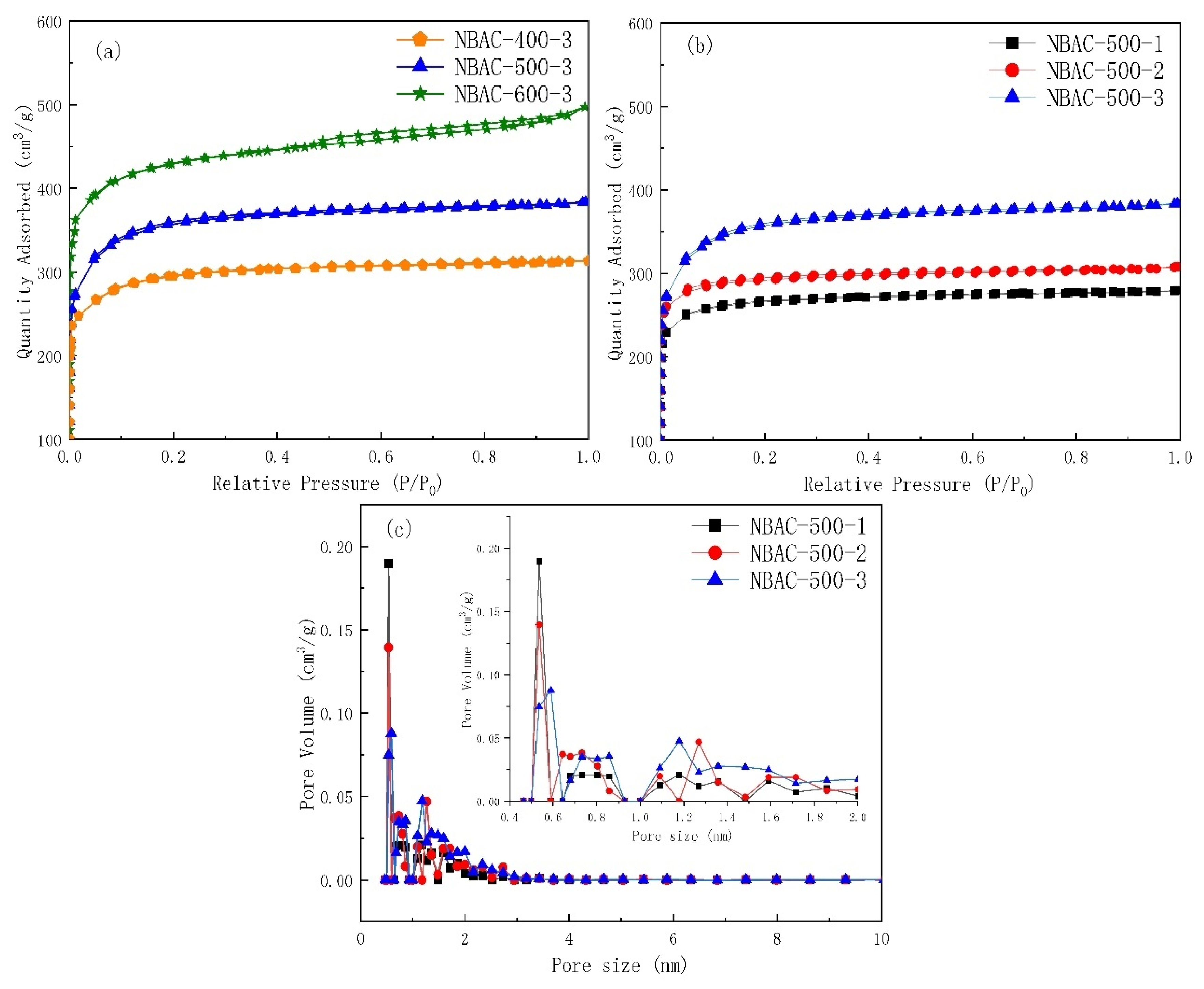

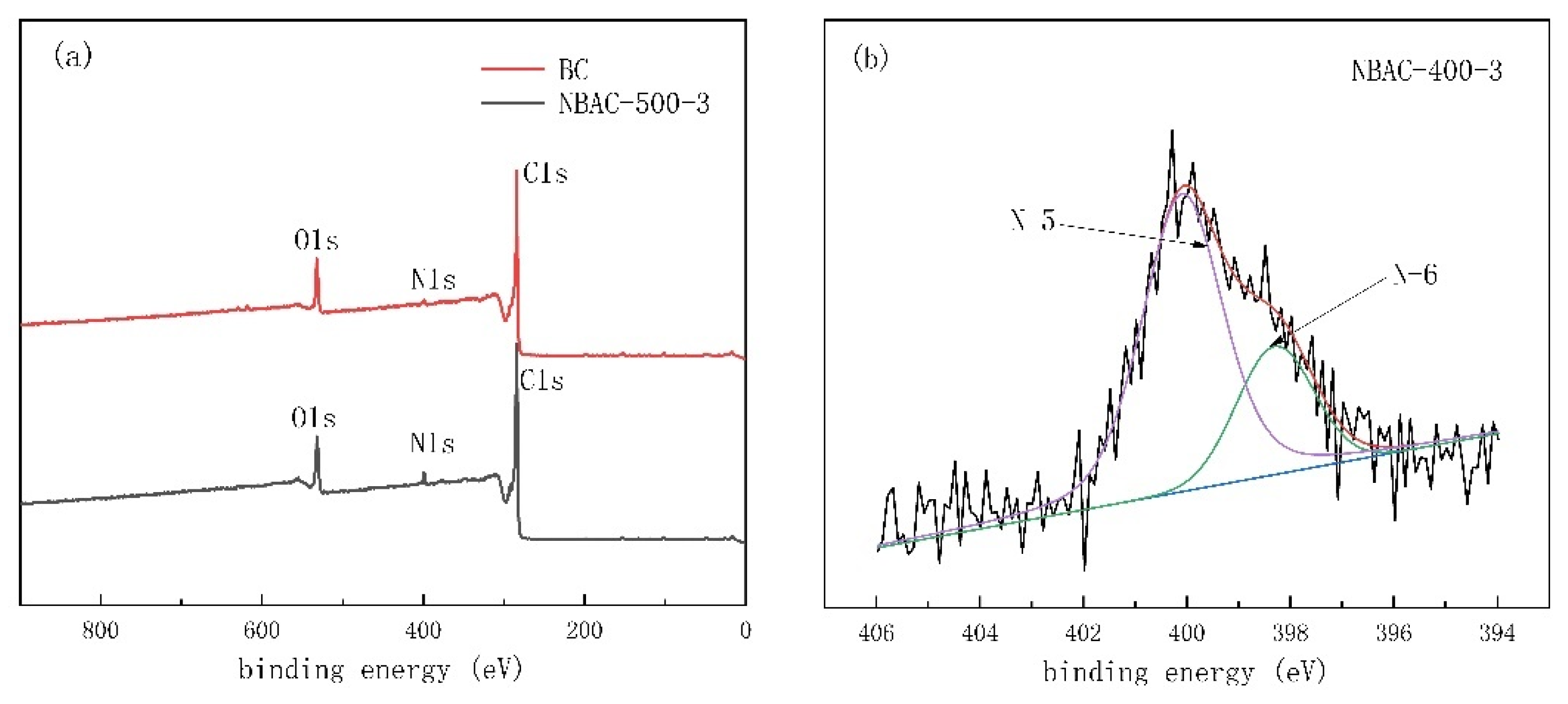
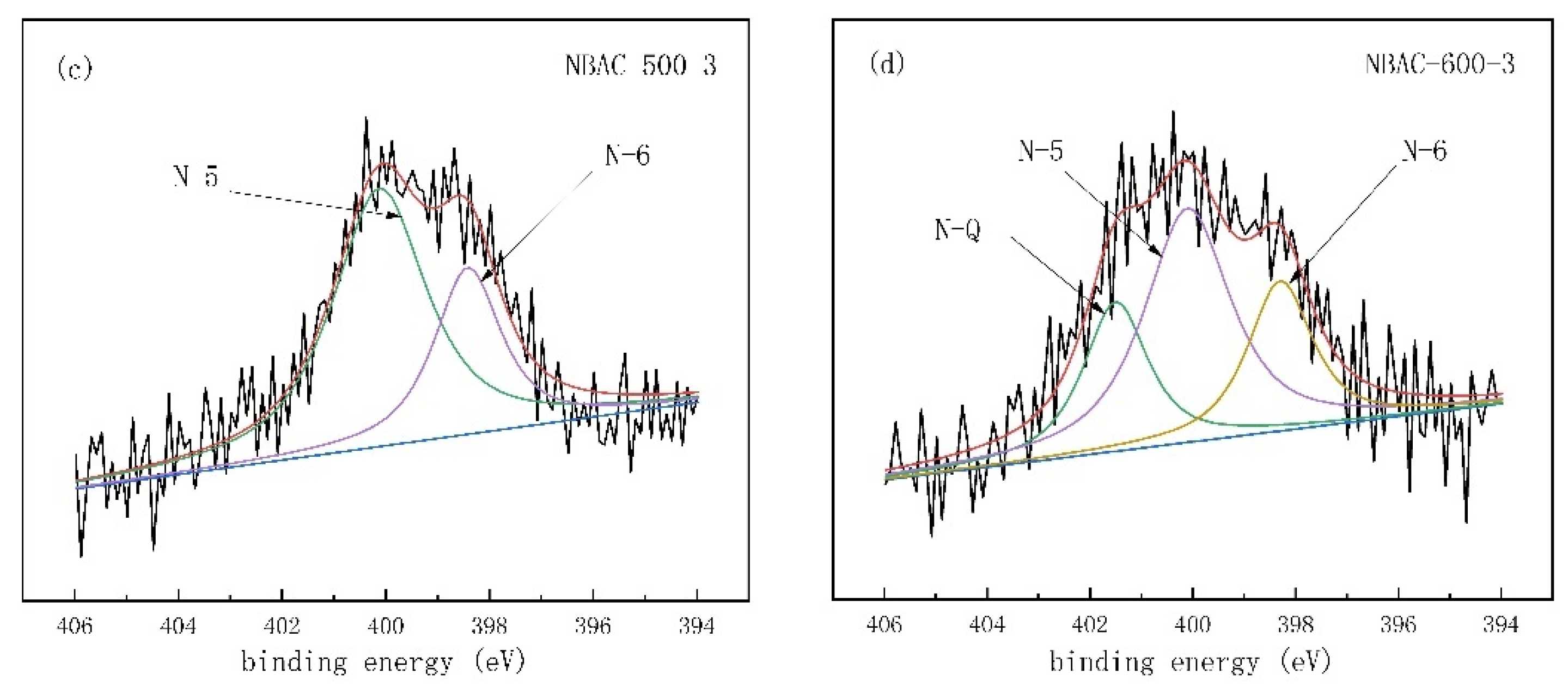
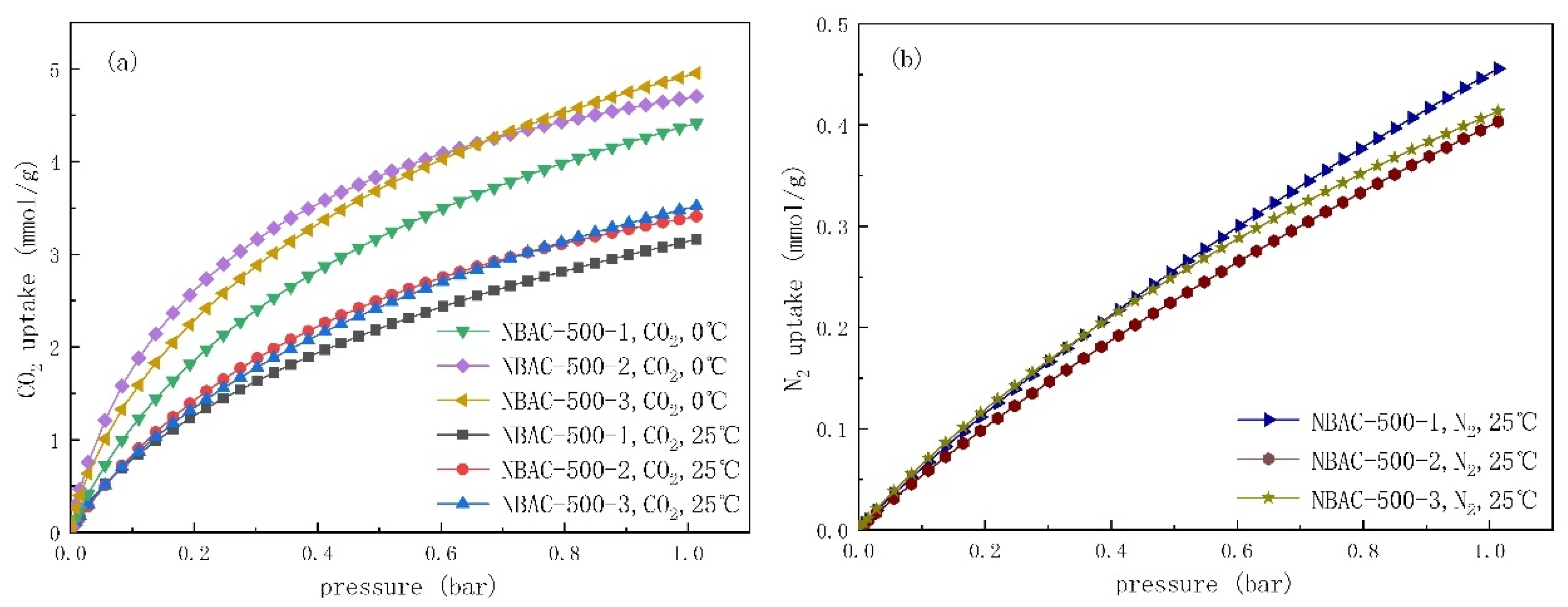
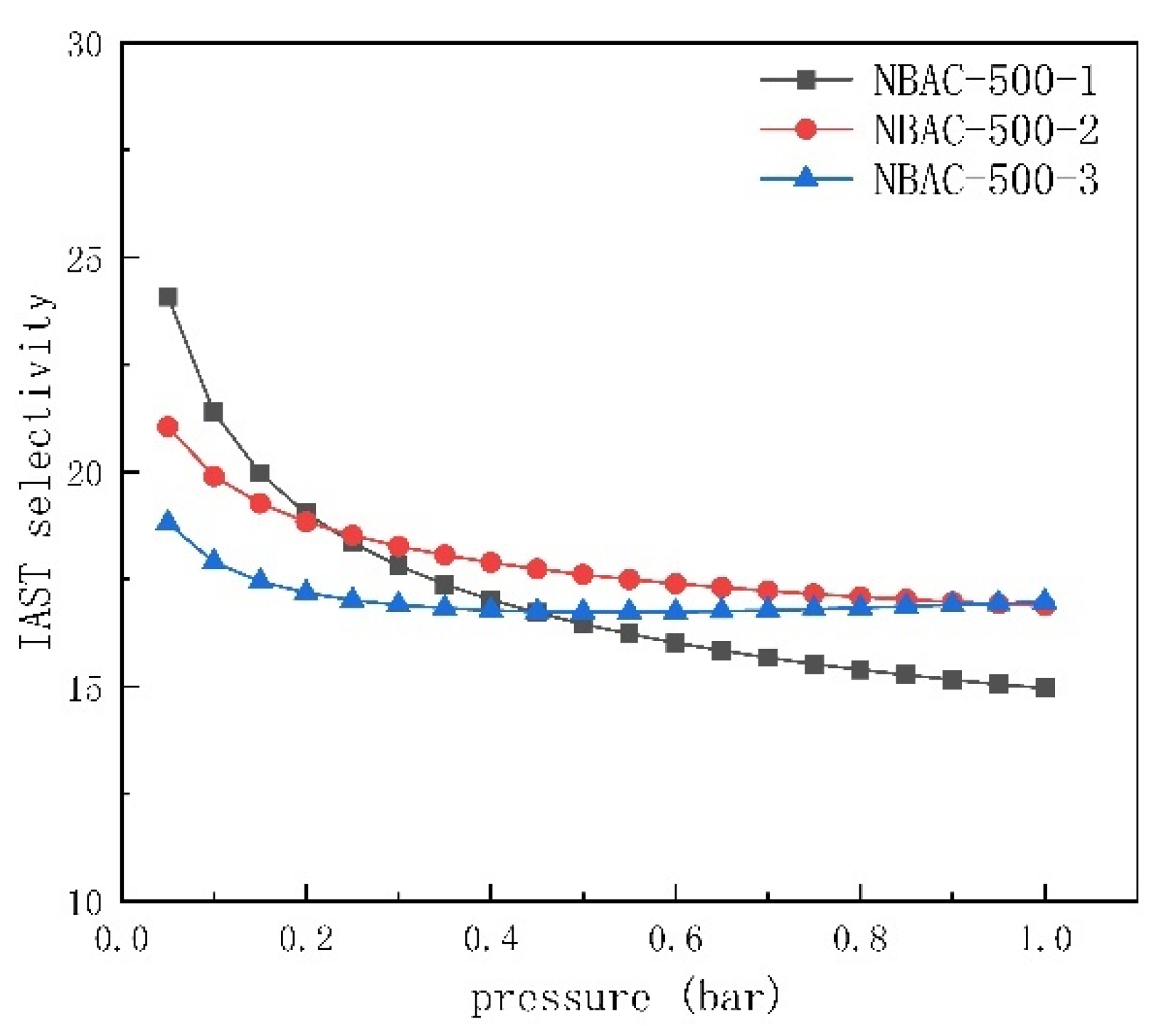

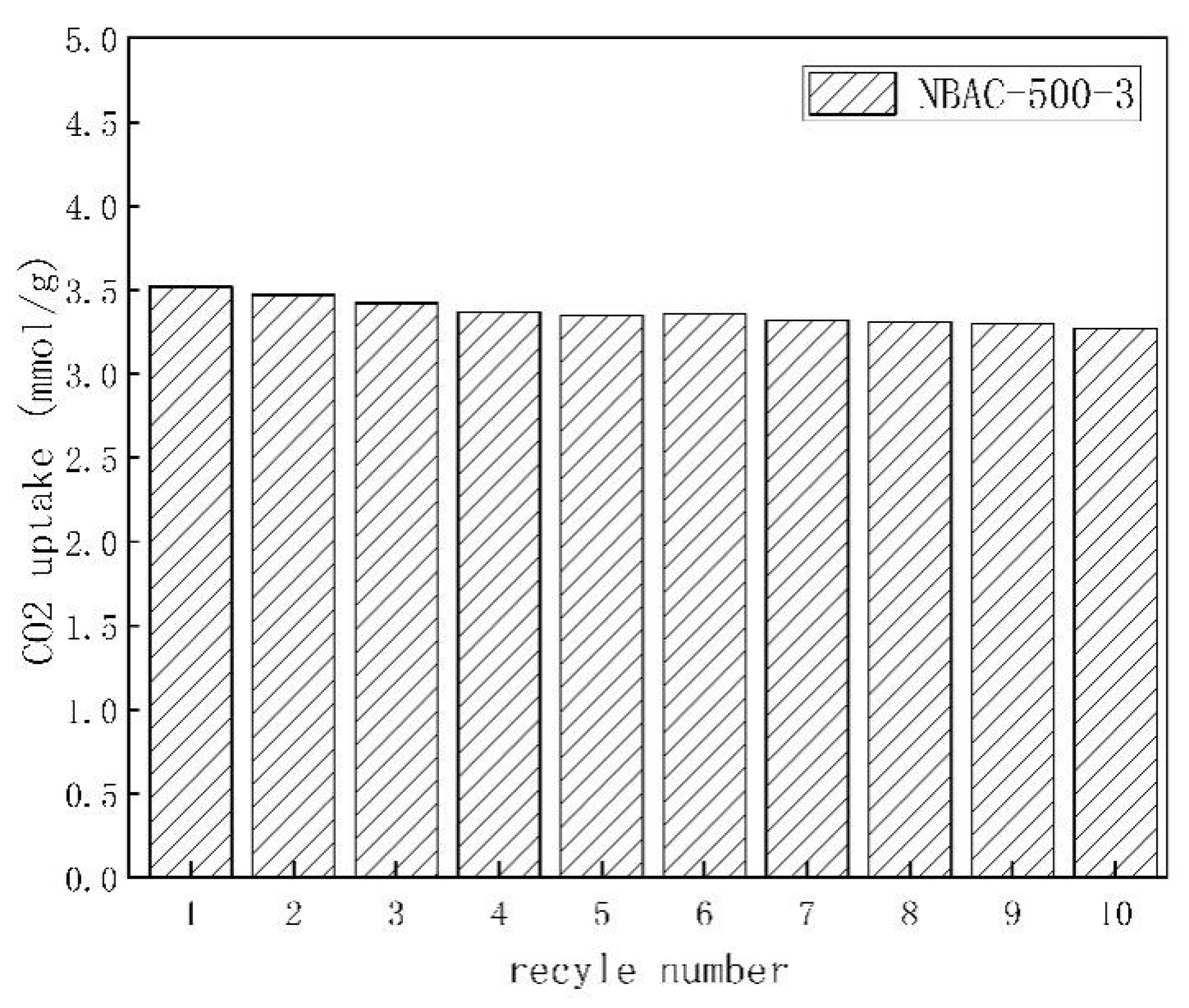
| Absorbent | SBET (m2/g) | Vtot (cm3/g) | Vmic (cm3/g) | Vmic/Vtot (%) | V(0.33–1 nm) (cm3/g) |
|---|---|---|---|---|---|
| NBAC-400-1 | 756 | 0.300 | 0.271 | 90.33% | 0.219 |
| NBAC-400-2 | 927 | 0.370 | 0.322 | 87.03% | 0.229 |
| NBAC-400-3 | 1068 | 0.450 | 0.381 | 84.67% | 0.241 |
| NBAC-500-1 | 1025 | 0.420 | 0.369 | 87.86% | 0.271 |
| NBAC-500-2 | 1175 | 0.506 | 0.426 | 84.19% | 0.285 |
| NBAC-500-3 | 1286 | 0.631 | 0.508 | 80.51% | 0.282 |
| NBAC-600-1 | 1227 | 0.543 | 0.441 | 81.22% | 0.276 |
| NBAC-600-2 | 1458 | 0.675 | 0.500 | 74.07% | 0.281 |
| NBAC-600-3 | 1489 | 0.682 | 0.480 | 70.38% | 0.233 |
| Absorbent | N (wt%) | C (wt%) | H (wt%) |
|---|---|---|---|
| BC | 0.26 | 83.5 | 3.12 |
| NBAC-400-1 | 3.25 | 71.2 | 2.98 |
| NBAC-400-2 | 3.89 | 72.6 | 3.05 |
| NBAC-400-3 | 4.12 | 72.9 | 2.79 |
| NBAC-500-1 | 2.51 | 73.2 | 2.43 |
| NBAC-500-2 | 2.85 | 75.1 | 2.34 |
| NBAC-500-3 | 3.21 | 74.6 | 2.05 |
| NBAC-600-1 | 1.98 | 76.2 | 1.78 |
| NBAC-600-2 | 2.15 | 77.3 | 1.81 |
| NBAC-600-3 | 2.35 | 78.5 | 1.69 |
| Absorbent | CO2 Uptake (mmol/g) | N2 Uptake (mmol/g) | |
|---|---|---|---|
| 0 °C | 25 °C | 25 °C | |
| NBAC-400-1 | 3.68 | 2.49 | 0.33 |
| NBAC-400-2 | 3.78 | 2.68 | 0.35 |
| NBAC-400-3 | 3.85 | 2.91 | 0.36 |
| NBAC-500-1 | 4.41 | 3.16 | 0.45 |
| NBAC-500-2 | 4.71 | 3.41 | 0.40 |
| NBAC-500-3 | 4.95 | 3.52 | 0.41 |
| NBAC-600-1 | 4.48 | 3.05 | 0.49 |
| NBAC-600-2 | 4.31 | 3.21 | 0.45 |
| NBAC-600-3 | 3.76 | 2.78 | 0.46 |
| Commercial BAC#1 | / | 1.43 | / |
| Commercial BAC#2 | / | 1.87 | / |
| Commercial BAC#3 | / | 2.21 | / |
| Absorbent | Adsorbate | qm | b | n | R2 | Selectivity |
|---|---|---|---|---|---|---|
| NBAC-500-1 | CO2 | 8.02 | 0.65 | 0.772 | 0.99 | 15.03 |
| N2 | 2.51 | 0.219 | 0.943 | 0.99 | ||
| NBAC-500-2 | CO2 | 7.47 | 0.84 | 0.865 | 0.99 | 16.87 |
| N2 | 2.23 | 0.218 | 0.946 | 0.99 | ||
| NBAC-500-3 | CO2 | 7.76 | 0.83 | 0.85 | 0.99 | 16.97 |
| N2 | 1.35 | 0.436 | 0.936 | 0.99 |
Publisher’s Note: MDPI stays neutral with regard to jurisdictional claims in published maps and institutional affiliations. |
© 2022 by the authors. Licensee MDPI, Basel, Switzerland. This article is an open access article distributed under the terms and conditions of the Creative Commons Attribution (CC BY) license (https://creativecommons.org/licenses/by/4.0/).
Share and Cite
Ying, W.; Tian, S.; Liu, H.; Zhou, Z.; Kapeso, G.; Zhong, J.; Zhang, W. In Situ Dry Chemical Synthesis of Nitrogen-Doped Activated Carbon from Bamboo Charcoal for Carbon Dioxide Adsorption. Materials 2022, 15, 763. https://doi.org/10.3390/ma15030763
Ying W, Tian S, Liu H, Zhou Z, Kapeso G, Zhong J, Zhang W. In Situ Dry Chemical Synthesis of Nitrogen-Doped Activated Carbon from Bamboo Charcoal for Carbon Dioxide Adsorption. Materials. 2022; 15(3):763. https://doi.org/10.3390/ma15030763
Chicago/Turabian StyleYing, Weijun, Shuo Tian, Huan Liu, Zenan Zhou, Grantson Kapeso, Jinhuan Zhong, and Wenbiao Zhang. 2022. "In Situ Dry Chemical Synthesis of Nitrogen-Doped Activated Carbon from Bamboo Charcoal for Carbon Dioxide Adsorption" Materials 15, no. 3: 763. https://doi.org/10.3390/ma15030763
APA StyleYing, W., Tian, S., Liu, H., Zhou, Z., Kapeso, G., Zhong, J., & Zhang, W. (2022). In Situ Dry Chemical Synthesis of Nitrogen-Doped Activated Carbon from Bamboo Charcoal for Carbon Dioxide Adsorption. Materials, 15(3), 763. https://doi.org/10.3390/ma15030763





